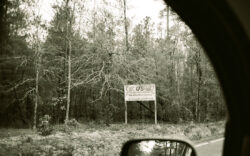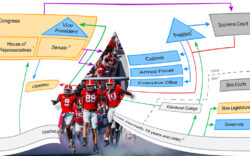From the front our house looks abandoned: overwhelmed by an out-of-control magnolia, ivy, scrub oaks, fire ant mounds, last year’s leaves. We put all our energy into the garden in the back that few people ever see. It seems rank hypocrisy for this yardman to write about landscaping, but fortunately, there are experts willing to help out. I talked with Nick Lapointe, co-owner of Normal Landscape Cooperative, and also with my friend Chris Adamson, a local landscape/land planner, who basically does the big stuff but shared some of his insights applicable to fixing up a yard. I also talked with a local landscaper who is a solo practitioner and wants to keep his business small and personal. He was happy to share his experience and insights but didn’t want me to use his name because he just can’t handle any more customers right now. I hope he won’t mind if I refer to him herein as “Ghost” because Halloween is approaching, and “Mr. X” sounds so impersonal.
Ghost caught on immediately that this story is not about bulldozers and big bucks but is an attempt to share some information with Flagpole readers who may feel the need to make their yards work a little better without taking on a major expense.
“You can find out what you like by walking around town. We’ve got some great streets. What a good way to put on a mask, especially outdoors, and there are a lot of people not working, with time now for their gardens. Tell a gardener you’d love to see their garden; it’s the best compliment you can give. You can even offer to help, and if they need stuff divided, that’s a good way to get extra plants.”
Ghost also recommends the State Botanical Garden as a good, free, outdoor place to get ideas for your own botanical needs.
While acknowledging that every yard has its own considerations, Lapointe says you’ve got to start with the practical things that you can’t get around, like drainage—where the water is going—and access: you don’t want to erect something that is going make your house and yard inaccessible to people who come to paint, landscape or haul off debris, etc.
Lapointe also says keep in mind what would improve the look and functionality of your yard without fighting the existing context.
“You could change everything, but it’s easier to work with the conditions that are already there,” he says. “For example, if you’ve got a lot of trees in place, don’t do grading to disturb the roots.”
As to plant choices, “We tend to use native plants, not exclusively,” Lapointe says. “We use a core palette that we know tends to do pretty well in different conditions: camellias, anise, viburnum, Sweet Bay magnolia, Southern magnolia. Also, if people are interested in edible fruit, figs and blueberries. They do pretty well without a ton of attention.”
Adamson, accustomed to large projects, narrowed his focus to explain that much depends on the particular lot, the style of the house, the architecture. He suggests framing things, as in a painting—a ground layer with low-lying plants, then shrubs, understory trees and larger trees as focal points. But don’t skimp on just one or two plants. Use them in groups of three, five, seven, etc. to lend some presence. Depending on what you like, your garden can range from the natural, English garden all the way up to the strictly formal. But space plants for the future, because they’re going to grow.
With an eye on cost, Adamson suggests an incremental approach. “You may not be able to afford to do everything at once. For instance, when creating beds, you can make a mulch bed with no budget. It’s environmentally conscious. Dig it out and fill it up with organic matter—leaves, grass trimmings—and keep adding to it, cover it with pinestraw and then fill it up with plants later.”
Adamson also likes the idea of creating garden rooms. “Outside the porch could be a more formal garden room transitioning to the less formal backyard, with maybe a garden room on the side of the house that is more of a working-type garden where you’re doing things like composting.”
Then Adamson let slip some inside dope that allows anybody to design a garden. “Take a hundred-foot garden hose and lay it out on the ground. Form it into S-type curves, kind of like the Pepsi-Cola logo. Those curves are real pleasing to the human eye. Move it around until it looks good from all angles—from the back porch, out the kitchen window, etc. It’s a real good way to visualize. Then spray paint that line and start cutting away turf.”
Irrigation is important, too, and Adamson says you can either have it done professionally or for $100 in materials, you can do it yourself and lay plastic hose with emitters. He makes it sound easy.
Finally, I asked Ghost the grass question: How much is too much? He points out that wildflowers and plants need work. “The lowest maintenance is a tree,” he says. “Just dig up your yard and plant understory trees and a small grass area.” He does concede, though, that with kids at home these days, they need room to run off energy.
“Getting people away from grass is tricky,” he says. He is amazed by the ubiquity of lawns in Athens and the amount of pesticides and fertilizers that wash off them.
There are more and more lawns in town,” he says. “They’re creating the suburban environments they grew up with.” Ghost says bringing the lawns to intown Athens began seven or eight years ago. “Yonah, Satula. It’s a big shock to see the old yards disappearing. It’s always nice to have a little pocket of them.”
Well, thanks, guys, and here’s hoping this whets some appetites. There’s plenty of information online and in books, and there are lots of people like these ready to offer some guidance or to do it all for you. And remember, old Flagpoles make excellent mulch.
Like what you just read? Support Flagpole by making a donation today. Every dollar you give helps fund our ongoing mission to provide Athens with quality, independent journalism.










